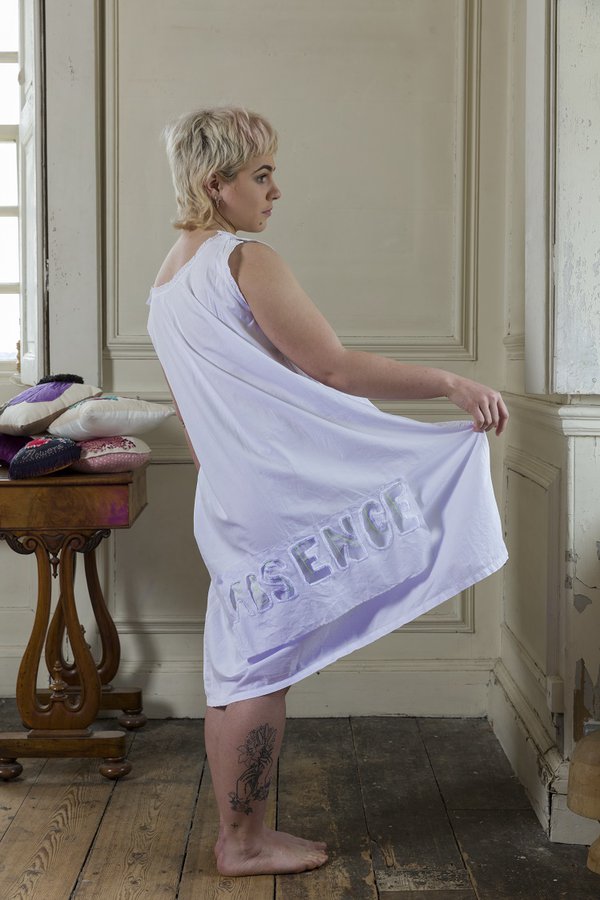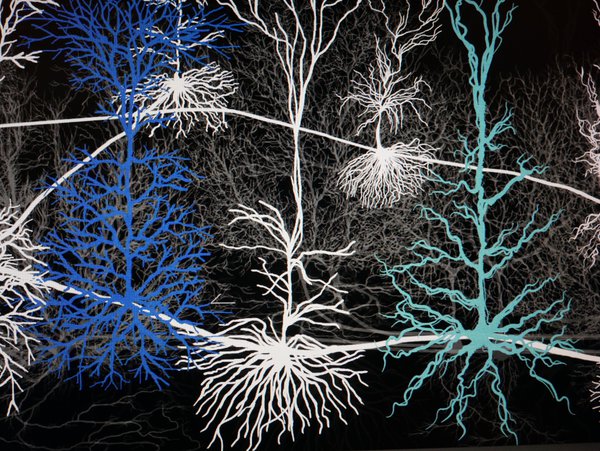Fascinating exhibitions explore epilepsy and the science of optogenetics
Illuminating the Self opens at Hatton Gallery and Vane Gallery in January
Illuminating the Self
Hatton Gallery: 18 January – 9 May 2020
Vane Gallery: 17 January – 29 February 2020
January 2020 sees two remarkable new exhibitions which respond to ground-breaking research at Newcastle University into a new treatment for epilepsy.
Collectively titled Illuminating the Self, the exhibitions at Vane and Newcastle University’s Hatton Gallery will show new work by artists Susan Aldworth and Andrew Carnie, and explore different aspects of the University’s CANDO project (Controlling Abnormal Network Dynamics using Optogenetics).
Themes within the two exhibitions include the human perspective of living with epilepsy and the neurological processes happening within the brain. Both artists are concerned with the hidden aspects of epilepsy, whether that is revealing the inner workings of the brain or expressing how it feels to have epilepsy.
On display at Newcastle University’s Hatton Gallery (18 January – 9 May 2020) Aldworth’s principal work, Out of the Blue, represents the experiences of people living with epilepsy through art and the cutting-edge brain implants being developed by the CANDO project to try and control focal epilepsy.

Over fifty people living with epilepsy contributed their highly personal experiences to Out of the Blue. They came from all ages, diverse backgrounds, and from as far afield as Kenya, the USA and, of course, the UK. For many, it is the first time they have publicly shared their feelings, either as a sufferer, or carer of someone living with epilepsy.
This was followed by a successful national appeal, which found 100 experienced embroiderers and needlework specialists who volunteered to assist Aldworth sewing the testimonies of people living with epilepsy onto 100 items of Victorian underwear using UV threads; to represent the hidden nature of epilepsy, now made public through the embroidered words.
Inside the space, the garments have been attached to pulleys and motors, which shake in the manner of an epileptic seizure, while UV and blue lights shine onto the work to illuminate the wording.
“The idea is to present the hidden experience of epilepsy on garments usually obscured beneath our clothes,” explains Susan. “The installation brings the experience into the public domain. The threads fluoresce under UV light, effectively mirroring and representing the optogenetics employed in CANDO’s remarkable work.”
“The entire piece is programmed to move in the neural patterns and pathways associated with epilepsy. The movement will become increasingly synchronised and, once fully aligned, they will collapse onto the floor. Slowly, the clothes will start to move again, and restore themselves into their original configuration,” Aldworth adds.
The significance of the 100 embroiderers and 100 items of clothing is also poignant, as epilepsy affects 1 in 100 people and uncontrolled seizures can have devastating effects on people’s lives. Out of the Blue seeks to highlight the experience of living with epilepsy and create a discourse about the ethical and personal implications of the CANDO implants.
“Each embroiderer approached the text in their own way. I can only describe them as exquisitely sewn narratives. These garments capture both the individual intensity of the testimonies and the special relationship that developed between the words and the embroiderer,” Aldworth states.
Carnie’s work for the two exhibitions reflects on both the CANDO project’s scientific and engineering aspects, whilst also considering some of the ethical and moral questions surrounding it.

For Illuminating the Self, Andrew made a new film which takes the visitor inside an imagined landscape of the brain. Here brightly coloured, tree-like forms move and shift mesmerically as activity in the brain is disrupted by a ‘seizure’. At other points, the viewer can see the CANDO device appearing within the brain, akin to a road sign indicating the seizure to halt.
Carnie has also created a series of kinetic sculptures that are triggered by visitors as they walk through each of the exhibitions. These pieces reflect on the nature of epilepsy, and are concerned with balance and stability and how this can be interrupted and realigned.
“The role of the audience is critical, as they form a part of the work triggering some of the sculptures actions. While focused upon the CANDO research, epilepsy is not an isolated condition, its effects are social as well as medical. While the optogenetics research using light to control cells in living tissue may have an impact beyond epilepsy and upon us all,” Carnie says.
Andrew’s work also invites the viewer to consider the beauty of the brain and some of the complex issues surrounding how the introduction of a piece of scientific technology might alter the way we feel about our identity, being human and how the constant monitoring of the brain could affect our sense of self.
The Vane exhibition includes a series of Aldworth’s cyanotypes - a historic photographic technique, which uses UV light to develop the prints. These artistically mirror the blue light used by optogenetics in the CANDO project. She says: “The cyanotypes are made using ultraviolet light, a process which mirrors the use of light in the optogenetic therapies being developed by the scientists. These prints explore, through pattern, the synchronization that occurs in the brain during an epileptic seizure.”
Susan’s prints will be exhibited alongside multi-image portraits of three people with epilepsy.
Lucy Jenkins, Curator of Illuminating the Self says: “In Andrew's film we can see the brain imagined as an idyllic landscape - a perfect Garden of Eden. Gradually technological interventions appear within the landscape prompting questions about the impact of introducing something new within such unique beauty and how it might alter the sense of self.
“Other interventions reflect on wider ethical questions about the technology. Watchtowers act as metaphors for the monitoring of the device, but are they benign or malevolent? Is it the implant watching out for abnormal activity so that it can intervene with its therapy, or is there more to it? Andrew invites us to ask who is in the watchtower? What are they doing with all of the information and data that they are collecting?”
Dr Fiona LeBeau of the CANDO project at Newcastle University says: “By combining genetic engineering with brain implants we are on the verge of being able to use light to control brain cell activity and treat conditions like epilepsy. This offers hope to the many patients who do not respond to medication to control their seizures. Engaging the public and in turn creating awareness about the science we are employing through these exhibitions, can also help to shape future work, by ensuring that medical research works for the people it is intended for.”
Illuminating the Self is funded by Wellcome.
For more information about Illuminating the Self at Hatton Gallery and Vane, please visit www.cando.ac.uk, www.hattongallery.org.uk or www.vane.org.uk.
Follow the exhibitions on Twitter @CandoNcl and using #illuminatingtheself
About the artists
Susan Aldworth is a visual artist who lives and works in London. She has a background in philosophy, and a strong interest in investigating the workings of the human mind, especially consciousness and our sense of self. Working as an artist-in-residence in a medical or academic setting is central to Aldworth’s practice – she has collaborated with scientists, clinicians and philosophers to investigate the many narratives of sleep, epilepsy, schizophrenia, consciousness in her explorations into what it means to be human. She has developed experimental print techniques to realise her ideas, including the historic Transience etchings printed directly from human brain tissue. Her work is held in many public and private collections including the V&A, the British Museum, The Fitzwilliam Museum, The Wellcome Collection Library and Williams College Museum of Contemporary Art, USA. Aldworth is an associate lecturer on the MA Art & Science at Central Saint Martin’s, London. She has exhibited widely both nationally and internationally most recently The Dark Self at York St Mary’s, Realisation at The Fitzwilliam Museum in Cambridge and Susan Aldworth: The Portrait Anatomised at The National Portrait Gallery in London. More at www.susanaldworth.com
Andrew Carnie is an artist and academic at Winchester School of Art, Southampton University. His practice often involves meaningful interactions with scientists. He is a member of the Critical Practices Research Group at WSA where his own interests lie in exploring the self, through notions of hybridity, in organ transplantation and immunology, other themes and ideas are often based around neurology, the brain, and how we get a sense of ourselves through science ideas, and images. Carnie’s work is often time-based in nature, involving slide dissolve systems or video projection onto complex screens. In darkened spaces layered images appear and disappear on suspended voiles, the developing display absorbing the viewer into an expanded sense of space and time through slowly unfolding narratives that evolve around them. His work has been exhibited at the Science Museum, London, Natural History Museum, Rotterdam, Design Museum, Zurich, Exit Art, in New York, Williams College Museum of Art, Williamstown, Great North Museum, Newcastle, Pera Museum, Istanbul, Dresden Hygiene Museum, Morevska Gallery, Brno, and the Daejeon Museum of Art, South Korea amongst many others. More at www.andrewcarnie.co.uk
.



